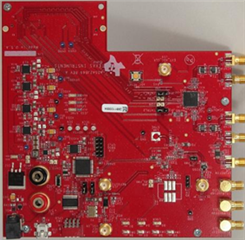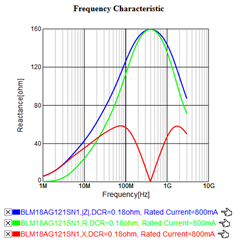Other Parts Discussed in Thread: ADS42JB46EVM,
Hi everyone,
I have a question about the "VCC parts of LMK04828" in ADS42JB46EVM design schematic.
Why the FB (Ferrite Bead) is chosen as 120OHM@100MHz but not other size?


This thread has been locked.
If you have a related question, please click the "Ask a related question" button in the top right corner. The newly created question will be automatically linked to this question.
Hi everyone,
I have a question about the "VCC parts of LMK04828" in ADS42JB46EVM design schematic.
Why the FB (Ferrite Bead) is chosen as 120OHM@100MHz but not other size?


Hi Nan,
This is copying what was done on the LMK04828BEVM, and follows our recommended guidance for ferrite beads in the datasheet (between 100Ω to 200Ω at range of 30MHz to 3GHz).
Our LMK04828 datasheet goes into detail explaining how we arrived at our ferrite bead guidance. That said, there are some questionable decisions made early in the LMK04828BEVM layout which have remained with the schematics ever since, like the choice to use a second layer of ferrite bead (FB4) for some supplies. I recommend reading the datasheet for LMK04828, especially figure 41 and section 11, for detailed guidance on ferrite bead choice and placement.
Regards,
Derek Payne
Hi Derek,
I have seen the datasheet about the recommended FB configuration, but it said that if the signal frequency is higher than 30MHz, then use FB, but which size I should use? Is it designed by my signal frequency or what?
Regards,
Nan
Nan,
Selection of ferrite bead is less about blocking specific frequencies than about covering the gap created between the internal LDO response, reasonable bypass capacitance values, and the on-chip bypassing frequency response. LDOs begin dwindling above 10MHz; bypass capacitances can help in the 10s of MHz range before getting to very small values; and there is enough on-board decoupling capacitance and bondwire inductance to limit the amount of noise above roughly 1GHz escaping the power supply pins and off-chip bypassing. But in that range of approximately 30MHz to 1GHz, another form of noise rejection is required. We generally recommend 100Ω to 200Ω centered around 100MHz, no specific impedance requirement at 30MHz but higher is usually better. Ferrite bead characteristics are usually more favorable at frequencies above 100MHz, so in the range of 10MHz to 100MHz we rely more heavily on the local bypassing capacitor with the ferrite bead providing only some rejection.
Our EVM uses BLM18AG121SN1D from Murata. This is certainly not the only possible ferrite bead choice, but it illustrates the desired characteristics: about half the maximum impedance at 30MHz, overall impedance is never higher than 200Ω, and acceptable effectiveness up to 1GHz (although impedance begins to diminish rapidly). If you are looking for similar devices, this is marketed as 120Ω @ 100MHz.

Regards,
Derek Payne